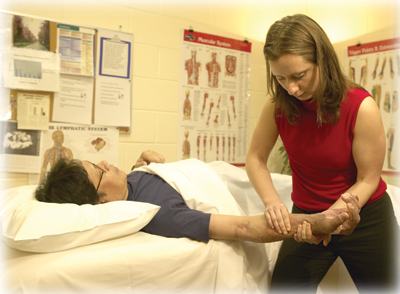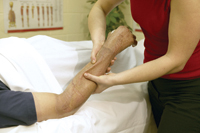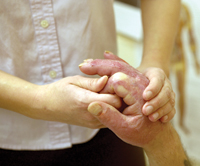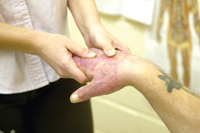
Features
Practice
Technique
Burn Rehabilitation
St. John’s Rehab Hospital, a recognized leader in burn rehabilitation, has incorporated massage therapy into their multi-disciplinary rehabilitation program. Through the clinical application of treatment-based massage over the past few years, the benefits of massage therapy have become increasingly recognized and burn patients are referred to massage therapy for treatment of scar tissue,
September 28, 2009 By Anna Kania B.Sc RMT & Kimberly Boersen-Gladman BRLS RMT
The physiological perspective of burn scar tissue and the integration of Massage Therapy into a multi-disciplinary burn rehabilitation program.
St. John’s Rehab Hospital, a recognized leader in burn rehabilitation, has incorporated massage therapy into their multi-disciplinary rehabilitation program. Through the clinical application of treatment-based massage over the past few years, the benefits of massage therapy have become increasingly recognized and burn patients are referred to massage therapy for treatment of scar tissue, itching, pain, and dysfunctions of compensatory structures /related to the injury/resulting from the injury.
 |
|
|
Anatomy Of The Burn Scar
understanding the characteristics of burns and burn scars is key in the development of a treatment plan
 A burn is a specific type of wound caused by a thermal agent which can cause internal or external tissue damage ranging from mild tissue irritation to severe tissue damage and, if extensive or severe enough, death.
A burn is a specific type of wound caused by a thermal agent which can cause internal or external tissue damage ranging from mild tissue irritation to severe tissue damage and, if extensive or severe enough, death.
The thermal agent can be fire, hot liquid, chemical source, flash flame (where the heat causes the burn), or an electrical source. For the purpose of this article, we will focus on external thermal agents, which result in the damage to the largest organ of the body – the skin.
The skin has a number of very important functions such as protection of internal structures from the external environment, injury and exposure. As well, the skin is important for temperature regulation and plays an important sensory role as there are various nerve endings (temperature, pressure, pain) situated in the layers of the skin.
| Table 1 • COMMON SIGNS AND SYMPTOMS |
When there is extensive damage to the skin layers, these important functions are compromised and various symptoms arise as a result (see Table 1).
Skin is composed of three layers: the epidermis, the dermis and the subdermal layer.
The epidermis is the outer most layer, which is avascular. The cells of the epidermis have a relatively short life span and the deeper epidermal layer is continuously producing the cells to create a new epithelial lining to maintain the integrity of the epidermis. The dermis is the deeper layer of skin, which is composed of elastin and collagen (giving the tissue flexibility and strength) and contains hair follicles, subaceous and sweat glands, lymph and blood vessels, and nerve receptors. The deepest layer is the subdermal layer where deeper hair follicles are situated as well as adipose tissue and larger blood vessels. (Rattray and Ludwig, DeLisa J.)
It is important to have a basic understanding of skin structure as the classification of burns is based on the extent of tissue damage to the respective layers. Burn injuries are typically classified into one of the following categories (O’Sullivan and Schmitz, Rattray and Ludwig):
Superficial Burn (1st degree)
• Tissue damage involves the epidermis only. Healing usually occurs within 2-5 days, and the formation of scar tissue is uncommon. A sunburn is a classic example of a 1st degree burn.
Superficial Partial Thickness Burn (2nd degree)
• Tissue trauma involves the complete destruction of the epidermis layer and mild to moderate damage of the upper dermis layer. Symptoms include: redness, localized swelling, and can be very painful as nerve
endings in the dermal layer can be irritated or damaged. Re-epithelialization of the burned area with minimal scarring is possible if it is a relatively superficial injury. However, as the damage to the dermal layer is deeper, epithelialization becomes more difficult and a much longer healing time is required, often resulting in fibrosing, contracturing, and the potential for development of hypertrophic and keloid scars.
Deep Partial Thickness Burn (2nd degree)
• Tissue trauma results in the complete destruction of the epidermial layer and severe damage of the dermal layer. The damage to the integrity of dermal layer, sweat gland and sebaceous glands and hair follicles will have a strong impact on the length of the healing process and the characteristics and functionalities of the resulting scar tissue. As well, due to the damage of lymph and vascular vessels, swelling will be very pronounced and the nutritional supply to these tissues compromised.
Full Thickness Burn (3rd degree)
• Tissue trauma results in the full destruction of the epidermis and dermal layers as well as the subdermal layers. Tissue regeneration may occur at the borders of the wounds, however, due to the extent of tissue destruction there are no viable areas for tissue regeneration within the skin and skin grafting is often necessary.
 Phases Of Healing
Phases Of Healing
There are two healing processes the skin can undergo determined by the layer of the skin that has been damaged: epithelialization and scar formation.
Epithelialization occurs when there is superficial damage to the epidermis, as observed in a superficial burns. Healthy epidermal cells will divide, multiple and move across the open wound to cover it. This process often results in minimal or no scarring.
Due to the destruction of the epidermal layer in deep partial thickness and full thickness burns, the healing elements of the epidermis are not available and the dermal healing process involves the deposition of collagen, leading to the formation of a scar. The dermal healing process is longer (up to three years before the scar matures) and often results in pervasive scarring. It involves three phases: Inflammatory (Exudative) Phase; Proliferative (Granulation) Phase; and the Maturation (Remodelling) Phase.
The Inflammatory Phase involves clotting, moving substances such as fibrinogen, neutrophiles and monocytes to fight bacteria to the area.
During the proliferative phase, fibroblasts migrate and proliferate deep in the wound, synthesizing scar tissue. This scar tissue is composed of collagen fibres that are deposited in a random and unorganized alignment, creating a restrictive matrix with in-elastic properties of the scar tissue. This often results in poor scar tissue pliability and mobility. (Silverberg et al, 1996)
The Maturation Phase is defined by reduced activity of the fibroblasts and a decrease in the vascularity of the scar. It is a time where there is a balance between collagen synthesis and breakdown and the collagen begins to re-model. It becomes more parallel in arrangement and stronger bonds are formed between the collagen fibres (Field et al, 2003; O’Sullivan and Schmitz, 1994).
 The Rehabilitation Of Burn Patients
The Rehabilitation Of Burn Patients
Once the burn survivor has undergone acute care at a hospital and wounds have healed, the patient is discharged and (usually) continues their recovery at an appropriate rehabilitation facility.
The primary objective of this phase is developing optimal long-term function and re-integrating the individual back into society.
The rehabilitation program, which is developed by the clinical team, is patient specific and involves passive and active range of motion exercises, strengthening, swelling management, pain management, scar tissue
management, undergoing retraining to carry out activities of daily living and at times reconstructive and/or release operations.
The multi-disciplinary team works with the burn patient in order to address the various needs of the patient and to optimize function, regain independence and re-integrate the individual back into society.
At St. John’s Rehab Hospital, massage therapy is part of the multi-disciplinary team involved in the treatment and recovery of burn patients in the maturation phase of burn scar tissue healing.
Given the complexities involved in burn rehabilitation, what role can and does massage therapy play?
| Table 2 • ABNORMAL SCARRING COMMON IN BURN PATIENTS (Bay at et al, 2003, Edwards J. 2003) CONTRACTURES: Due to the lack of epithelialization, the body attempts to close the wound by contracting in order to bring the edges of the wound together. If the contracting of the scar is not HYPERTROPHIC SCARS: These are scars develop due to the exaggerated response of fibroblasts in depositing excess collagen, and stay within the boundaries of the original wound. They are thick, rigid, red (as these scars tend to be hypervascular), itchy and often. Although they may spontaneous regress over time, they pose a hindrance in the rehabilitation process of burn patients since they result in a thicker, tougher, less mobile scar compromising their function of the joints and underlying soft tissues. As well, itching is often associated with hypertrophic scars, which can be debilitation both functional and psychological end. KELOID SCARS: These are characterized by a raised and darkened scar which extends beyond the |
1. The “Good Quality” Scar
Scar management is one of the key components of burn rehabilitation and the team of therapists closely monitors the healing and maturation of the scar with the goal being the development of a good quality scar which is characterized as being flat, pale and pliable (Baryza MJ et al, 1995).
As well, the team monitors and develops appropriate treatment protocols in order to prevent and treat contractures, hypertrophic scars and keloid scars – complications which commonly develop in individuals who have sustained extensive deep second or third degree burns (Table 2).
Massage therapy intervention can play a very important role in scar management and achieving goals such as: reducing scar thickness, banding, adhesions, and increasing the mobility and pliability of the scar. Various textbooks and articles discuss the application of various massage techniques (frictions, s-bowing, skin rolling, stretching) to burn scars (DeLisa; Edwards J 2003; LaFrano 2001) as part of scar tissue treatment and management.
It is proposed that the application of massage techniques may distort the collagen fibres and may also break up the bonds forming adhesions between layers of tissues or between the collagen fibres.
This may account for the softening of restrictive fibrous bands, increase the inter-fibre movement not only
in the scar tissue but also between soft tissue layers resulting in greater tissue mobility (Edwards J, 2003, LaFrano 2001).
Since collagen is characterized as being rather in-elastic, the idea of elongating or stretching the burn scar is questionable (Pation et al 1999).
The concept of remodelling, relating to HOW collagen is laid down, may be a more plausible explanation as to how massage techniques improve the quality of the scar tissue. The application of massage techniques may re-align fibres in a more symmetrical fashion rather than the random manner, which may effect the overall appearance and pliability of the scar tissue.
Although it is often noted in research that there is insufficient scientific evidence on the effects or the effectiveness of massage therapy in the treatment of burn scar tissue (Bayat et al, 2003; Pation et al 1999; Silverberg et al 1996), massage techniques are commonly used as part of the treatment protocol for burn scars by various disciplines (physical therapy and occupational therapy).
The discipline of massage therapy has a unique position in the specific treatment of burn scar tissue; massage therapists have the knowledge of not only a wide range of massage techniques, but also well-developed palpation skills. This unique skill set enables massage therapists to be more specific in locating adhesions, determining which techniques are most effective, monitoring tissue response, and differentiating between various types of tissues (for example: scar tissue, muscle, fascia).
Monitoring scar tissue response to massage techniques (especially vigorous techniques such as frictions) is particularly important with burn scar tissue since it is compromised and can be susceptible to breakdown. It is always good practice to monitor the response of scar tissue to determine the appropriateness and effectiveness of massage intervention.
2. Pruritis (Severe Itching)
Individuals with burn scars frequently report severe itching. Field et
al report incidence of pruritis of up to 87 per cent in adult burn
patients (Field et al 2003). This itching may be caused by a number of factors: dryness (caused by the scar’s
inability to self-lubricate due to the damaged sweat glands), stiffness
of the tissue, and it is a common symptom of the wound healing process.
The pruritis may vary from a mild irritant to being debilitating in terms of activity levels and the individual’s psychological well-being. Field et al comment that “severe itching has also been associated with anxiety and sleep disturbances.” (Field et al
2000, 1998). Although the mechanism is uncertain at this time, there
are a number of studies that indicate the effectiveness of massage
therapy in reducing the severity and/or intensity of the itching and
often times a complete resolution with an extended treatment time frame (Patino et al, 1999, Boersen, 2001).
These positive effects may be caused by the application of lotion
during massage, which lubricates the skin, and the increased mobility
of the tissue with massage intervention.
3. Edema
Ongoing, low-grade edema of burned and grafted extremities is very common. As such, swelling
reduction and management is key as it contributes to joint stiffness and compromises the health of already fragile tissue.
Furthermore, vascular beds may be damaged or destroyed in deeper burns (2nd and 3rd degree burns), hence there is compromised circulation in the affected area.
Massage therapy is strongly indicated for swelling reduction as the application of specific lymphatic drainage techniques can accelerate the activity of the lymphatic system and decrease fluid accumulation in affected regions (Griffiths, J.; Harris, R 1994). Swelling reduction is also important in facilitating the healing process and promoting tissue health.
 4. Pain
4. Pain
The burn patient experiences a variety of pain syndromes due to the trauma sustained by the tissue and compensatory changes to surrounding structures.
Pain is also potentially exacerbated by such factors as painful nature of treatments (from specific exercises such as stretching, to scar massage and dressing changes) to immobility caused by scar tissue or splints as indicated (Keith, 1998). As such, treatment and management of pain is often a very important component of a treatment plan.
There is a wide range of research supporting the effectiveness of massage therapy in pain reduction and management (Field et al 2000; Moyer, C. 2004). Potential mechanisms have been proposed to explain how massage therapy reduces pain.
The tactile contact with soft tissues during massage results in the stimulation of afferent nerve endings which may over-ride the pain signals, as explained by the Wall and Melzak’s Gate Control Theory. Due to its effect on increasing local and peripheral circulation, massages may remove chemical by-products of an inflammatory period that irritate pain nerve endings. The tightness and restrictions of soft tissues involved and decreased the joint mobility often results in myofascial pain syndromes and joint pain, which can be effectively treated with massage therapy.
5. Skin Hyper-Sensitivity
Hypersensitivity of the scar and surrounding tissue is a common symptom experienced by burn patients. Although the specific mechanism of how massage reduces skin sensitivity is unknown at this time (Field et al, 2000; Roques, C 2002), many clients report a reduction over time with massage intervention.
| Summary Table 3 • INDICATORS FOR REFERRAL OF BURN PATIENT TO MASSAGE THERAPY • Development of a good quality scar – scar management is an essential aspect of out-patient burn therapy • Reduce or prevent contractures from forming, • Reducing pruritis (itching) • Swelling reduction – burned and grafted extremities commonly have lingering edema that can result in pain (due to compression on underlying structures) and joint stiffness • Pain reduction and management • Reduce hypersensitivity of the skin • Treatment of the underlying soft tissues (i.e. muscles, fascia) • Prevent dysfunction of compensatory structures • Preparing the tissue for stretching and strengthening exercises • Assist in management of psychological symptoms |
6. Surrounding Soft Tissue
Muscle and fascia located around and underneath the burn scar also need to be addressed as spasms, tightness and adhesions frequently occur due to damage from the initial trauma and pulling on the surrounding tissue as the scar progresses through its healing phases.
Splinting and anti-deformity positioning to prevent contractures is one of the priorities in rehabilitation beginning in the acute phase. Since joints maybe left immobile for an extended period of time, capsular restrictions and shortening of muscles and tendons may occur.
Massage therapy is highly indicated for such individuals in order to “stimulate movement between muscle fibres, which results in more fluid muscle movement” (Patino et al 1999). As well, reducing soft tissue restrictions and trigger points in compensatory structures not directly affected by the burn injury can be of great benefit in preventing the development of myofasical pain syndromes. It is interesting to note that many out-patients treated at St. John’s Massage Clinic reported that the reduction in the tightness, stiffness and pain with massage intervention resulted in increased ease of movement and hence greater ability to participate in stretching and strengthening exercises.
Lastly, psychological symptoms such as depression, anxiety and stress may be experienced by the burn survivor. There are a number of research studies supporting the effectiveness of massage therapy in reducing these symptoms (Field et al 2000; Moyer C 2004). As many writers and researchers have commented, the psychological effects of therapeutic touch cannot be underestimated.
In Conclusion
The clinical experience of the massage therapists working with burn survivors at St. John’s Rehab Hospital supports the effectiveness of Massage intervention on scar tissue quality, the treatment of related itching and pain, and the treatment and prevention of soft tissue dysfunction of compensatory structures.
In conclusion, the integration of massage therapy into burn rehabilitation is highly supported.
References
JOURNAL
- Baryza MJ, Baryza GA. “The Vancouver Burn Scar Scale: an administration tool and its interrater reliability.” Journal of Burn Care and Rehabilitation. Sep-Oct 1995; 16 (5): 535-8
- Bayat A., Mcgrouther, D A., Ferguson MWJ. “Skin Scarring” British Medical Journal. 1/11/2003; 326 (7380); 88.
- Boersen, K. “Treating post-burn pain and injury: Massage Therapy and Rehabilitation,” Rehab and Community Care management. Fall 2001
- Edwards, J. “Scar Management.” Nursing Standard. Sept 2003; 17(52).
- Field, T., Peck, M., Hernandez-Reif, M., Krugman, S., Burman, I., Ozment-Schenck, L. “Postburn Itching, Pain and Psychological Symptoms Are Reduced With Massage Therapy.” Journal of Burn Care and Rehabilitation. May/June 2000; 21(3); 189-193.
- Field, T. Peck M., Krugman, S. Tuchel T. Schanberg T, Kuhn C. , Burman, I. “Burn Injuries Benefit from Massage Therapy.” Journal of Burn Care and Rehabilitation.1998 19(3):241-244.
- Griffith, J. “Lymphatic Drainage – What it can really do.” Massage Australia. 36:7-10.
- Harris, R. “Edema and its treatment in massage Therapy.” Journal of Soft Tissue Manipulation. 1994. 1(4).
- Keith, J., “Pain management in burned patients.” Pain Reviews Oct 1998 5(3).
- LaFrano, Chuck. “Scar-Tissue Massage.” Massage Magazine. May/June 2001. 151-160.
- Moyer, C. “Massage Therapy: Meta-Analytic Evidence for a Contextual Model” Pscyhological Bulletin. 2004. 130:3-18.
- Pation, O., Novick, C., Merlo, A., Benaim, F. “Massage in Hypertrophic Scars”. Journal of Burn Care and Rehabilitation. May/June 1999; 20(3); 268-272.
- Roques, C. “Massage applied to scars.” Wound Repair and Regeneration. 2002; 10(2): 126-9.
- Silverberg R., Johnson, J., Moffat, M. “The Effects of Soft Tissue Mobilization on Immature Burn Scar: Results of a Pilot Study” Journal of Burn Care and Rehabilitation. May/June 1996; 17(3):252-8.
BOOKS
- DeLisa, Joel A. “Rehabilitation Medicine: Principles and Practice. 2nd Edition,” JB Lippincott Company, Philadelphia, 1993.
- O’Sullivan, Susan B., Schmitz, Thomas J. “Physical Rehabilitation: Assessment and Treatment, 3rd Edition.” F.A Davis Company, Philadelphia, 1994.
- Rattray, F., Ludwig, L. “Clinical Massage Therapy.” Talus Incorporated. Toronto, 2000.
Two Case Studies
The following case studies, which analyze the effects of massage intervention, were carried out at St. John’s Rehab Hospital and were presented at the 2003 Eastern Great Lakes Burn Conference.
Purpose For The Case Study:
• In recognition that there is limited research supporting the direct effects of massage techniques in burn
rehabilitation, the objective is to demonstrate the functional outcomes of massage therapy when treatment is rendered as an integral part if a rehabilitation process. The massage therapists at SJRH collect outcome-based measures to assess the effectiveness of daily practices and to bridge the gap of the known affects of massage therapy and how they apply to the treatment of burn scars.
The Case Study:
• Two male subjects between the ages of 48 and 60 were recruited. Both had right hand dominant burns caused by an electrical flash were referred to massage therapy for swelling and scar tissue treatment. Participants fulfilled the following criteria, indicating appropriateness for massage therapy referral and intervention: participation in a regular rehabilitation program, wound closure, infection free, tissue fragility was acceptable for manual pressure application, provided consent to treat and report on findings.
The Treatment Protocol:
Both received 30 minutes massage therapy treatment two times a week during a six-week period. To reduce scar tissue, massage therapy was applied using the palmer surface of hands or pads of the fingertips from the periphery of the scar towards the centre; direction of the movement was cross-fibre/transverse, parallel, vertical and circular. Fascial techniques, skin rolling, picking up, frictions and flushing techniques were applied. Pressure was mild to moderate based on tolerance and tissue response. A standard water-based lotion was used for massage.
To reduce swelling in the hands and forearms, superficial drainage techniques was applied using mild pressure with the intention of activating the lymphatic system to pick up excess waste products thus reducing swelling. The superficial lymphatic techniques were applied on alternate days to the scar tissue treatment. The rhythmic “pumping” action was applied in an unidirectional method, towards the heart.
The time of massage intervention was based on the client’s preference and to optimize therapy outcomes.
Client A reported that his pain and swelling increased significantly post stretching and requested his massage intervention be applied upon the completion of his active rehabilitation program. Client B, on the other hand, reported waking up in the morning with significant pain and stated he was able to participate in stretching and his active program with greater ease if massage was applied prior to active therapy.
Measuring Outcomes:
The outcome measures used pre- and post-treatment were:
• Girth measures (in cm); volumetric measures (ml) for swelling measures;
• Vancouver Burn Scar Index – measures of scar quality;
• Modified McGill Pain; Questionnaire and the Numerical Pain Rating Scale – pain measures;
• Gonimetry – Range of motion measures.
The Results:
In both case studies the results were a reduction in swelling and pain, and improved range of motion. Analyzing the results collected from both cases, edema reduction </= 25ml during the six-week period of massage intervention was noted (see chart 1 for client A and B). Both clients reported pain reduction post treatments as well as a steady decline in the pre treatment rating over the duration of the treatment plan (see chart 2 for client A and B). In addition, both clients experienced changes in the appearance of the scar, as indicated by the Vancouver Burn Scar Index and photography (visual documentation).
As a side note, client feedback was very positive and patient satisfaction was met. Both clients reported that they never expected such results from massage therapy and that they felt is was a necessary aspect of their rehabilitation journey.
Print this page